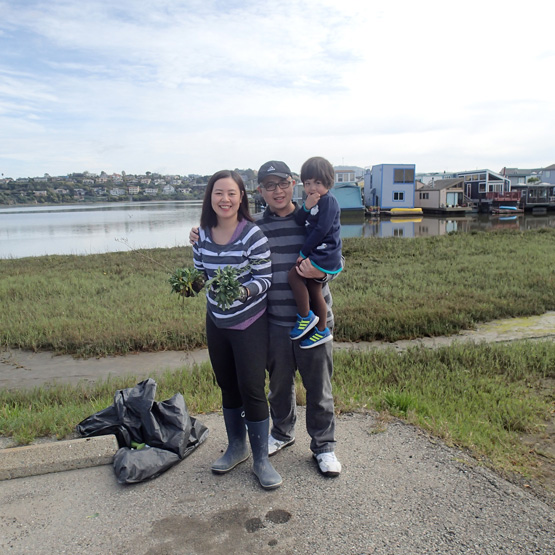The Marin Audubon Invasive Sea Lavender Removal Project welcomes volunteers. To RSVP for a Sunday work session, please email Jude Stalker. You will receive notice of the date and location of any upcoming work sessions. All gloves, tools, supplies, snacks and instruction will be provided.
This is the story of a plant that snuck into our backyard and that now threatens to take over the upper zones of the marsh. Thanks to the efforts of one attentive marine biologist, several concerned botanists, a rotating corps of volunteers, and the coordinated efforts of multiple agencies, this invasive species is being thwarted. The plant? Algerian sea lavender—Limonium ramosissimum—nicknamed LIRA. It’s a plant native to the Mediterranean (Limonium is a genus of 120 flower species) and, along with European sea lavender—Limonium duriuscilum—threatens to overwhelm our own native sea lavender—Limonium californicum. LIRA is thought to have been introduced as an escapee from private gardens or plant nurseries.
For some time LIRA has been insinuating itself into the the salt marshes of the South Bay, crowding out the native species in the process. LIRA is just now coming into flower. Flowers whose sole purpose it is to create seeds that will produce a carpet of new plants around the “mother” plant and that will be carried on the tides and by the currents, to be deposited in fertile spots throughout the Bay, ready to take root. That makes this period, from mid March to mid May, the ideal time to uproot the invasive sea lavender before it sets seed.
You don’t need to know plant Latin to help out. For the past few years, Jude (pronounced Judy) Stalker has organized small bands of volunteers to help her tackle areas throughout Southern Marin, many of them situated around Richardson Bay. Several of the most recent work sessions have focussed on our own backyard: the stretches surrounding Kappas and leading out toward Gate 6 1/2 and the area flanking the bike path alongside Highway 101. Send Jude an email to receive advanced notice of where the next invasive species removal will occur. Work sessions for volunteers run Sundays from 10 a.m. to 1 p.m. (with a break on April 16 for Easter)—typically anywhere from three to eight people show up.
A marine biologist by training and on the board of the Marin Audubon Society (in charge of special projects), Jude first noticed the growing presence of LIRA several years ago while surveying the entire Bay shoreline for another invasive plant: the tall clumping Cordgrass—or Spartina. In addition to scouring the areas the Marin Audubon Society owns around the Marin shoreline, Jude has chalked up endless hours driving, walking, and even kayaking to map out where these plant species could be found. Around the same time as Jude was encountering LIRA, a biology professor at SFSU was encountering its European cousin. It took several botanists two years to verify exactly what they had stumbled upon.
Jude shares the recent history of sea lavender removal efforts around the Bay Area:
In 2011 Marin Audubon formed a partnership with the Bay Area Early Detection Network and we got volunteers to come and remove it from the locations where LIRA had been spotted. They never got all of it. Kathy Boyer, the professor of Biology (Wetland Ecology) at SFSU, who found the European sea lavender up at Strawberry Marsh, would bring her students out to remove it once a year. Over the years we’ve gotten it at certain sites; we’ve never gotten it at all the sites and we’ve never gotten all of it out, mainly due to my own time restraints (or limits). Even though I’m doing the work for and with the Marin Audubon—it is my passion—I’m volunteering my time. [researching parcels, requesting permission, coordinating work crews, working alongside volunteers]
Last year the California Invasive Plant Council secured some funding to deal with invasive sea lavender—Bay-wide—but they don’t have enough funding deal with all of it. They were able to get to some of the sites in the South and Central Bay and treat it. It’s so bad down there they had to spray it with chemicals. And they said they could take about two sites in Marin, so I suggested the Strawberry Marsh—it’s very dense there—and the Corte Madera Ecological Reserve. They did that, we did some, and the County of Marin did their sites, which at the time was Bothin Marsh and Seminary Drive.
Please, if you spot what you think is LIRA, don’t just pull it but instead drop Jude an email. She’ll then work out the removal with you.
In Marin County we still have a chance to manage the plant manually, with timely intervention, and concerted coordination—which is where Jude comes in. A good amount of her time has been spent researching land ownership, understanding parcel boundaries and approaching owners for permission. Not every property owner is thrilled with the idea of volunteers removing invasive species—yet gaining permission is a delicate but necessary part of this process. What we do know is that it’s not just one person’s problem. Left unabated, the seeds will spread with the tides to a neighbor’s property and then to their neighbors’ neighbors. Likely these removal efforts will need to continue for several years, as no one yet knows for how many years the seeds remain viable.
The goal this year is to remove every known invasive sea lavender plant from the Marin County shoreline. volunteercoordinator@marinaudubon.org
Related/follow up post: Learn Weed Management Skills – June 17







































